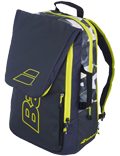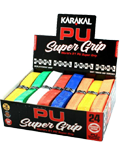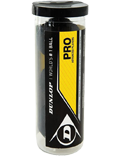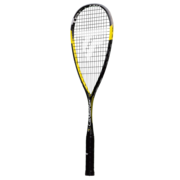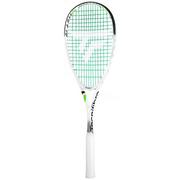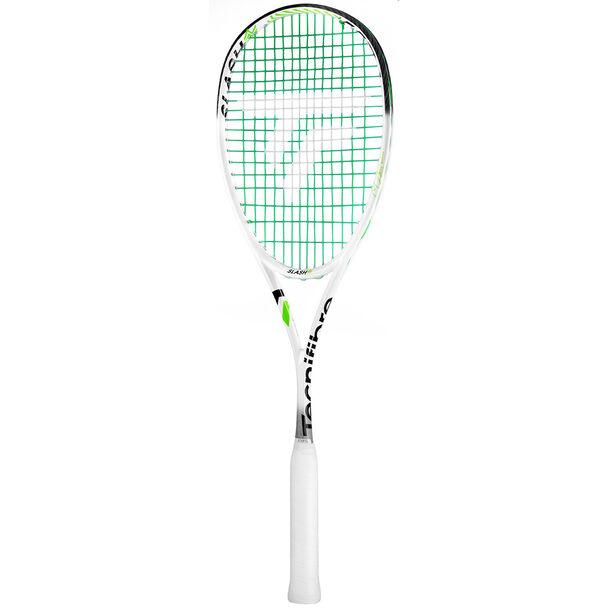Tecnifibre Slash 120 Control -- Precision Meets Power
Overview
The Slash 120 Control (2025) is aimed at advanced and competitive players who demand accuracy and manoeuvrability without sacrificing power. Designed in collaboration with Mostafa Asal, this racket blends a control-focused design (smaller head, thinner shaft, reinforced structure) with modern technologies to keep shots stable and sharp -- especially under pressure or during high-speed swings. It's ideal for players who generate their own power but want finer placement and feel.
Key Technologies
X‑Top Technology
The bumper has been removed and replaced with aramid fibres (with PTFE treatment) to improve resistance to impact and abrasion. This reduces weight at the top, helps maintain swing speed, minimises vibration, and enables smoother movement through the air.
Stabyl Technology
A mesh fibre (polyester mesh / mesh fibre) insertion in the shaft's graphite, which replaces the older internal rubber ring. It enhances stability on hard shots and helps reduce twisting or loss of precision under load.
Yoke Control Construction
The design features a wide open core ("yoke") with internal reinforcements, combined with a thinner shaft profile (≈ 261 mm²) and a smaller round head (≈ 461 cm²). This improves handling, enhances precision in the sweet spot, and gives better feedback on touch and control shots
Played by World Number One Mostafa Asal
Slash 120 Control Specifications
| Specification | Details |
|---|
| Material |
High‑grade graphite frame with composite reinforcements |
| Head Size |
≈ 461 cm² (≈ 71 in²) |
| Strung Weight |
120 g ≈ 4.2 oz |
| Balance |
≈ 350‑352 mm |
| Length |
27 in (≈ 68.5 cm) |
| String Pattern |
14 mains × 18 crosses |
| Pre‑strung |
Yes - with Tecnifibre 305 Green string |
Pro / Player Review
Strengths: Excellent control thanks to the smaller round head and thin shaft profile. The X‑Top construction improves dampening and durability, especially in frames without a traditional bumper. The lightweight design and reduced swing weight offer quicker response and better wrist action. It provides good stability under power due to the Stabyl reinforcements.
Weaknesses: Due to the smaller head size, the sweet spot is tighter -- making mishits more noticeable. It offers less inherent power than oversize or heavier power‑oriented rackets, so players who lack drive may need to work harder. Without a traditional bumper, it may be more prone to wear at extreme angles unless used with care.
Suitability: Best suited to players who already generate good pace, such as attacking or counter‑rallying players. Also ideal for tactical players who prioritise placement, accuracy, and deception. Less suitable for beginners, defensive players who rely on slicing, or those seeking maximum power with minimal effort.
Comparison: Compared to Tecnifibre's Carboflex series, the Slash 120 Control offers more precision but less oomph in terms of straight power. Versus the Slash Power versions (same weight class), it's less forgiving on full‑drive shots but provides tighter feel and greater control -- likely to appeal to those transitioning from power frames to a more touch-focused game.
Q: Is this racket good for players who don't use a lot of power?
A: Partly. It rewards players who can generate decent pace, as its control‑oriented design doesn't amplify weak shots like a power frame would. However, the reduced swing weight offers some compensation, making it more forgiving than older control rackets with heavier heads.
Q: How durable is the frame given there's no bumper?
A: The X‑Top construction (aramid fibres + PTFE treatment) is designed to protect the frame and resist abrasion even without a plastic bumper. For most players this will perform well, though as with all bumperless designs, greater care is needed when sliding or making contact with walls/floors. Use a cover and avoid harsh impacts.
Q: What tension should I string it at?
A: It comes pre-strung with 305 Green, which is relatively soft and comfortable. For optimal balance, string within the mid-range of Tecnifibre's recommended tension (≈ 20‑30 lbs). Players seeking more control may prefer slightly higher tension for a tighter response. Avoid extreme tensions to preserve both strings and frame integrity.











